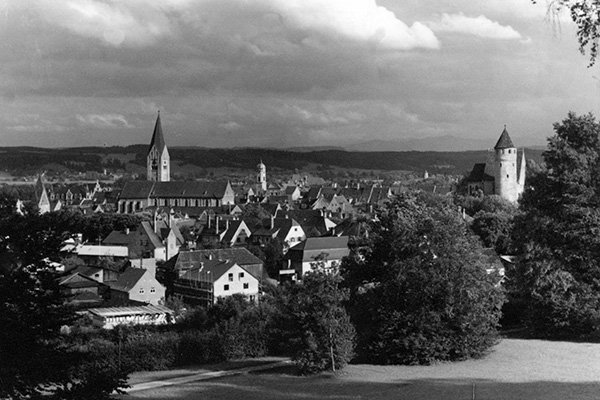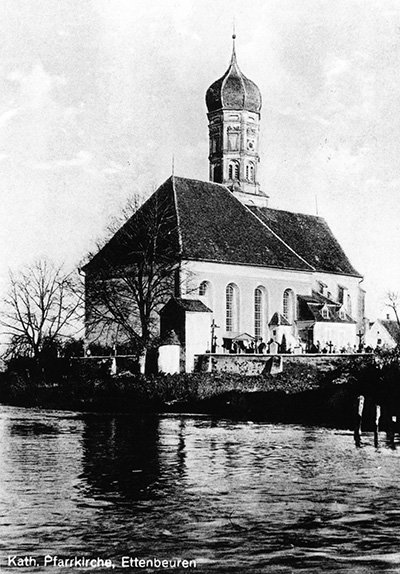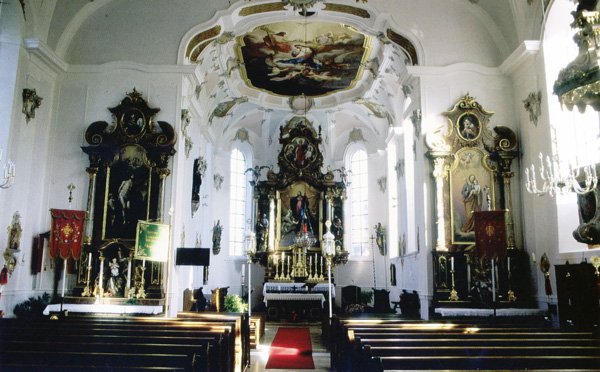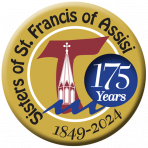History 1849-60
The Beginning
On March 13, 1849, 11 lay Third Order Franciscan tertiaries left Ettenbeuren, Bavaria. Their destination was the Diocese of Milwaukee, Wis. Milwaukee Bishop John Martin Henni traveled throughout Europe searching for missionaries – men and women willing to emigrate to America and serve the growing German population in the Milwaukee area.
Tertiaries are men and women who try to emulate St. Francis of Assisi’s spirit by performing works of teaching, charity, and social service.

Ettenbeuren, Bavaria village
The 11 tertiaries were led by Rev. Francis Keppeler and his assistant, Rev. Mathias Steiger. Six Tertiary women – Ottilia Duerr-Zahler (Mother Aemiliana), Anna Ritter (Sister Johanna), Crescentia Eberle (Sister Frances), Teresa Moser (Sister Angela), Margaret Saumweber (Sister Margaret), and Maria Eisenschmied (Sister Clara) – and five Tertiary men – Anton J. Zahler, Leo Bernard, Joseph Suess, William Reder and John Spitzelberger composed the Bavarian colony.
At the time of the arrival of the tertiaries, Bishop Henni had not yet returned from a council of bishops meeting. Finally, on Pentecost Monday, the 11 women and men presented themselves before Bishop Henni. This day -- May 28, 1849 -- is the Foundation Day of the Sisters of St. Francis of Assisi. Upon the bishop’s recommendation, the tertiary band settled south of the Milwaukee Bay of Lake Michigan. Native people, most likely the Potawatomi, called this strip of land “Nojoshing” – a strip of land extending into the water.
Immediately after purchasing land from Heinrich and Eva Gross, a new dwelling was planned. The log houses found on the land and hastily built frame houses became their temporary shelters. Everyone pitched in with clearing the land, rooting out tree stumps, carrying building materials, and the like. By December, a 60-foot by 60-foot square convent with an enclosed courtyard and well stood near Deer Creek. The Sisters moved in and the priests and Brothers took residence of the log and frame houses, and later a well-built dwelling of their own. Another structure was built – a chapel that was added to the convent. It also served as a church for the neighboring settlers.

Early Church
Years of Trial
Cholera
The first of several hardships came to the colony in 1851 – a cholera epidemic. First, Father Keppler, spiritual guide and leader, succumbed to the disease on September 9. Then on September 11, Father Steiger fell victim to cholera after administering the last rites at a home on Beloit Road (today’s St. Mathias Parish there bears Father Steiger’s baptismal name). Though both leaders were among the many who perished, none of the Sisters and Brothers died of the plague. The now-orphaned community feared disbanding.
The work of Fathers Keppeler and Steiger and the teaching by Mrs. Zahler and Miss Ritter provided the financial means to continue their ‘missionary’ work. Lack of a spiritual leader and financial support now loomed before the new community. It wasn’t until November 1852 that Rev. Michael Heiss was appointed spiritual director of the Nojoshing community. Father Heiss quickly wrote a daily program and a rule in accordance with the principles of religious life and they were approved by Bishop Henni.
The question remained: Financially, how would this five-year-old Franciscan community continue to exist? It was the future work at St. Aemilian’s Orphanage and at the seminary that provided resources for this newly-formed Franciscan community.
St. Aemilian’s
Cholera once again broke out in the Milwaukee area. In 1854, 49 orphaned boys took up residence at St. Aemilian’s Orphanage, located in Nojoshing. The child care and schooling were placed in the hands of the Sisters of St. Francis of Assisi. Financial assistance for the orphanage came from a variety of sources. These funds and donations of farm produce and other necessities covered most of the expenses. Misfortune, though, visited the orphanage more than once.
Fires destroyed the building. The first fire occurred on June 14, 1855, a year after a new wood frame building appeared at Nojoshing. A second fire occurred on June 14, 1855 – a careless carpenter started a fire for his glue. All burned down, except for a few walls.
After each disaster, the Milwaukee Catholic community shouldered the costs of rebuilding – a new enlarged building was constructed with the latest developments and modern improvements so as to better serve the boys and the Sisters.
Then, on December 11, 1895, a kerosene lamp exploded, causing destruction to the home. Only one wing was left standing. Despite these disasters, there was one constant in the boys’ lives – the nurturing care of the Sisters.
St. Francis de Sales Seminary
Bishop John Martin Henni had a dream – a diocesan seminary dedicated to St. Francis de Sales. With the arrival of the band from Ettenbeuren, Bishop Henni believed he had the workers to accomplish the task. Father Michael Heiss and Dr. Joseph Salzmann carried the burden of purchasing land, procuring financial assistance and contractors. But, it was from this band of 11 women and men that generous aid was given. Three of the men hauled lumber from the lake shore to the seminary’s building site; cleared parts of the forest for a brickyard; made hundreds of thousands of bricks; assisted with carpentry and mechanical work; and offered their service in many other ways.
The Sisters prepared the meals for the seminary’s construction workers. Other duties included: cooking over a fire of green logs on wood stoves; hauling water from a distant pump; making scores of loaves of bread by hand; washing laundry at an old-time washboard; ironing with flatirons; milking cows, then straining and carrying milk from the barn to the kitchen and cellar. At this time, the Sisters were compensated for their labors with food, clothing and other necessities.
After the seminary doors were opened, the Sisters continued with the cooking, laundry, and housework for the professors and students. The few Sisters performed these demanding tasks in addition to their convent and orphanage duties and responsibilities. It wasn’t until 1861 that the seminary paid $200 a year to the Sisters for their labors.
With the additional work load, the overburdened Sisters sought help. Between 1856 and 1860, postulants (a candidate seeking admission into a religious order) were admitted; but many left. Some of the difficulties for the new members were: the Americans did not feel at home with the six German-born founders; the inability to communicate with each other (German vs American); the seminary’s poverty affecting community life; the arduous work demanding strong and exceptional self-sacrificing women; the seminary limiting the number of postulants – only as many as were needed to do the seminary and orphanage work. Many a young woman became frightened by the workload and extreme poverty of the young convent. They returned to her own homes.
Founders Leave
One of the principal intentions of the Bavarian women coming to America was to found a religious congregation where the Sisters could lead a prayer-filled and contemplative life; but convent life was becoming more difficult. The Sisters were unable to provide the American meals requested by the seminarians and the postulants. Other unsuccessful endeavors occurred and discouragement set in. Amid the numerous domestic duties and responsibilities and farm work, Mother Aemiliana and her pioneer companions felt they could not continue their work. Tending to one menial task after another, Mother Aemiliana was unable to properly train the postulants in religious life.

Ettenbeuren Assumption Altar
Beginning in 1858, Rev. Leonard Batz became the convent’s spiritual director and chaplain. It was he who deemed convent life at Nojoshing unconventual. He convinced the community founders to place themselves under his direction. In his conferences, Father Batz would point out the hardness of their lives, saying “they were only the maids of the seminary.” He began to advise certain members to leave; declaring the convent would desolve. In fact, one of the founding members left in 1858 – Sister Clara Eisenschmied, who went to Watertown, Wis., to make a living as a seam- stress. Afterwards, the remaining Sisters became more despondent. The conferences continued; his plans becoming more evident – with the founders, forming a secluded Sisterhood patterned after the European contemplative orders. Dissension mounted. The founding Sisters now were determined to change their lot. Upon learning of their leaving, the seminary rector, Father Heiss, and the professors, opposed the plans but could not dissuade them of their decision.
On the evening of June 1, 1860, Mother Aemiliana, Sisters Johanna, Frances, Angela, Margaret and a novice, Sister Scholastica Geiger removed their religious habit, put on their civilian clothes and stepped into the nightfall. They headed for a small cottage, purchased by Father Batz, awaiting a letter from Europe which would give them entrance into a cloistered community abroad. A letter arrived weeks later, refusing the founders admission. The six women maintained themselves by hard work – becoming Father Batz’s housekeepers, sacristan and janitors at St. Mary’s Parish. The religious life these women envisioned in 1849 never came to light.
Upon their deaths, these courageous women were buried at Calvary Cemetery in Milwaukee on Father Batz’s lot. Their death anniversaries are:
- Mother Aemiliana Zahler – March 20, 1904
- Miss Crescentia Eberle (Sister Francis) – August 19, 1877
- Miss Ritter (Sister Johanna) – February 26, 1881
- Miss Teresa Moser (Sister Angela) – February 1892
- Miss Margaret Saumweber (Sister Margaret) – February 1892
